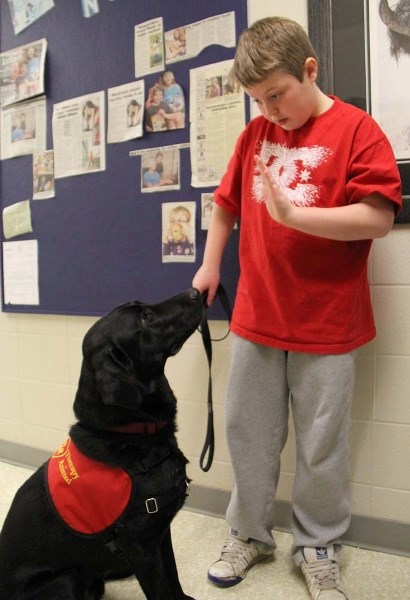"Find it," says Emma Willey meekly, pulling at the dog's leash.
Teaching assistant Anne Proulx cups a hand to her ear.
"Louder. He can't hear you," she coaxes.
"Find it!" Willey says again, this time loud and commanding.
Lewis, the three-year-old black Labrador, gallops down the hallway looking for the next clue in the game they are playing this afternoon.
Willey, 11, has global developmental delay, which means she has trouble with co-ordination, comprehension and speaking.
But during the last six months she has come out of her shell. She has learned new words and can more easily communicate. She is more sociable.
Therapy dog
Since September, Willey has been working with Lewis, a therapy dog at Keenooshayo Elementary School.
"It's great to see," said Adam Rurka, teacher of the grades 4, 5, 6 opportunities class at Keenooshayo. "She has even improved her fine motor skills by clipping on his leash to his collar."
Lewis is the school's first Chimo therapy dog. The non-profit organization founded in 1999 aims to recruit and certify therapy animals – including dogs, cats, birds, rabbits and miniature horses – and pair them with people in need.
Chimo therapy animals are used in programs at area hospitals (Glenrose Cognitive Impairment Unit), seniors' homes and schools.
"The focus is to engage children to strengthen their skills through utilizing an animal. An animal is a huge motivator," said Ann Campbell, educational facilitator with Chimo.
Every Friday, Lewis and his handler Judy Nickerson work with Willey and her teaching assistant for one hour. Activities range from a game of hide-and-seek to an obstacle course where Willey rolls a die and counts how many corresponding hurdles her canine pal has to jump over.
She also counts – out loud – how many treats Lewis will get.
"The activities have a goal at the end," explained Campbell. "Emma's speech skills are very poor … so in order for her to be understood by the dog, she has to speak clearly."
Brendan Lindbeck is another student who has a weekly one-on-one with Lewis. His goal was to get over his anxiousness.
"He helps me with my anxiety," said the Grade 5 student, described by teachers as a competent dog handler, burgeoning dog expert and confident public speaker (especially when it comes to dogs).
Lindbeck's visits with Lewis are less structured than Willey's. One day they may go for a walk and the next day he may help teach Lewis some new tricks.
"Sometimes trainers will train dogs to do extra fun things to make it more fun," said Campbell. "Part of the work with the client is to get them to train the dog to do something new."
Other days, Lindbeck will sit in the library and read a book with Lewis. The dog's presence dampens his restlessness, keeps him relaxed and attentive.
That's why Chimo dogs are specifically brought to post-secondary institutions – University of Alberta, Grant MacEwan University and NAIT – to help students de-stress.
The purpose of a Chimo dog is not solely to get petted and to lick your face, stressed Campbell. They are therapy dogs that work with professionals like teachers and psychologists.
This type of therapy, referred to as animal-assisted therapy, has been a growing area of research in recent years. Animals have become increasingly used in medicine for rehabilitation and pain management, in counselling and therapies for children with Fetal Alcohol Spectrum Disorder and autism.
Schools and beyond
A portion of Chimo's 40 dogs and dog handlers are currently visiting higher needs children in schools in Westlock and Clyde.
Keenooshayo is the only school in the St. Albert Public Schools district that is using a Chimo dog.
"Right now we're seeing how it goes at Keenooshayo," said Bev Baker-Hofmann, supervisor of student services. "It was a parent-initiated request. We have not had any other requests yet."
Baker-Hofmann has heard nothing but good things about Lewis' visits so far. The district spends $1,500 per year on the dog. She said she's open to having the program continue if the feedback remains positive.
Oak Hill School by Bon Accord, a residential treatment program that's part of the Sturgeon School Division, is currently using a therapy dog with their grades 4 through 9 students.
Principal Allan Traub began bringing his dog Rosie into the classroom in 2009. Rosie has since been Chimo certified and visits students every two weeks.
Certain factors determine whether a school gets a therapy animal, such as the number of higher needs children, funding and allergies.
"My goal is to have a dog in every school," added Campbell. "The dogs work so well with the kids and it's an inexpensive program for what you get."
She hopes to expand Chimo even further, into more summer camps, seniors' living facilities and domestic violence shelters.




